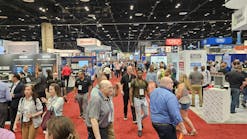Given the ongoing pivot in federal leadership on so many relevant issues, it was hard not to feel the swirling mix of anxiety, optimism, and curiosity permeating the packed meeting space for AHR Expo's annual 'State of the Industry' panel on Tuesday.
Some 250 attendees attended the one-hour session that featured insights from ASHRAE President M. Dennis Knight; National Comfort Institute CEO Dominick Guarino; Heating, Air-conditioning & Refrigeration Distributors International (HARDI) CEO, Talbot Gee; and The Air-Conditioning, Heating, and Refrigeration Institute (AHRI) President Stephen Yurek.
Once again, the popular annual discussion was moderated by Bryan Orr, host of HVACRschool.com.
"I don't know if everyone here is aware that there was an election a few months ago," said Yurek, tongue planted firmly in cheek, to start the event.
On Decarbonization
"We're at the stage now where most decarbonization initiatives are still moving forward, especially within the states," said ASHRAE's Knight. "But some things are up in the air now with all the new Executive Orders coming out of the White House."
In particular, 21 states are pushing aggressively to go all-electric, instituting various gas bans for appliances in new buildings. California and New York are leading that charge, causing widespread angst among HVACR manufacturers and distributors, added AHRI's Yurek.
"We all agree that the climate is the worst thing that you can base policy on," he said. "Those bans don't serve anyone well. Decarbonization is still going to be there, of course, but the fight is going to be different now."
Gee agreed. "We're going to fix New York," he vowed, referencing its gas ban. "It's just terrible policy there right now."
In Washington state, such initiatives were halted at the ballot box last fall. "The electorate there told politicians to slow down," noted Gee. "You can be pro-heat pump and anti-gas ban at the same time."
Refrigerant transition
"Contractors here need to be prepared for the transition and to stay focused," said NCI's Guarino. "And we need to push back on the YouTube videos and photos on social media that are trying to scare people about the transition."
Yurek and Gee also spoke to the widespread misinformation.
"Folks are out there saying that there is no alternative to 404, so people think they need to change everything today," Yurek noted. "But EPA has a timeline through 2028."
Gee noted that the flammability issue surrounding the new refrigerants is real to some extent, but has been overblown. "It's not hyperbolic, but it just needs to be managed carefully," he added. "It's been a pretty smooth transition so far, but this is going to be a tricky year... At some point, those existing refrigerants will turn back into pumpkins."
What's most promising?
"Inverter heat pumps," said Knight, the veteran engineer. "We're going to see a lot more innovation in that area."
Guarino took that question to a broader level.
"All the data we have at our disposal now," he said. "Never before have we been able to prove that we were able to do everything that we had said we were going to do. Today, our industry can back up everything with data."
IRA funding? Rebates? Tax credits?
In the ongoing political maelstrom, "we all need to take a breath right now," cautioned ASHRAE's Knight. "When everything stops shaking, we will see where the boulders fall... Many IRA funds that have now been frozen have already been allocated. So they will have to move forward at some point," he added, with a mix of both hope and hesitation.
Yurek was also guardedly reassuring. "It's very unlikely that there will not be any new (IRA) money doled out," he said. "Focus on the tax credits. They will be there for the next 10 years."
Regarding rebates, Gee cautioned, "Contractors should temper their expectations. This may all end up in court."
Workforce of the future
"Over the next 25 years, there will just be tremendous opportunity for our industry," said Knight. "Global population projections predict that we will be building a new New York or Chicago every month just to keep up."
HVACR systems are expected to triple worldwide over that time. "That's a lot of retrofits and replacement work," he noted. And as our workforce ages, this industry will need to attract and retain new talent on an unprecedented scale.
Added Gee, "Since Covid, we have seen greater interest in the trades. Our industry now needs to embrace that. We need to be infectious, tireless recruiting machines."











